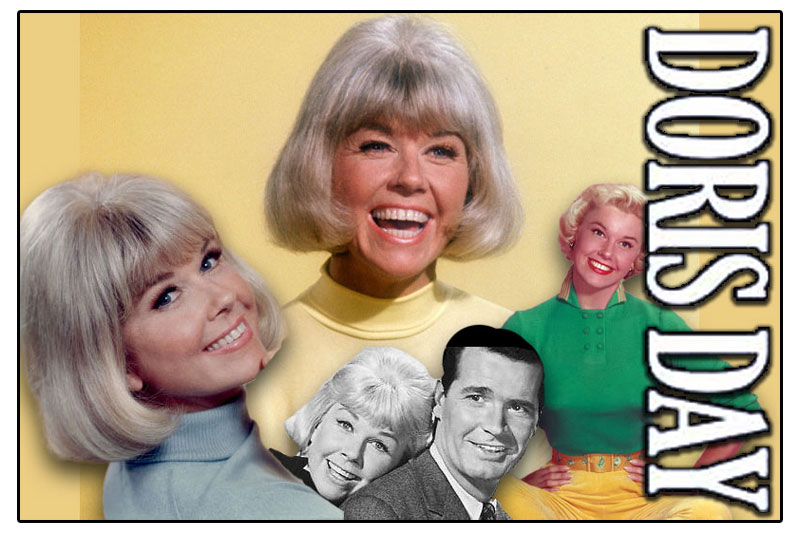 |


And there ain't nothing quite as sad
As watching your heroes die
One by one as they fall
Soon there'll be no heroes at all!
Who's going to fill their shose?
 |
|||
Ms. Day began her career as a big-band vocalist, and she was successful almost from the start: One of her first records, “Sentimental Journey,” released in 1945, sold more than a million copies, and she went on to have numerous other hits. The bandleader Les Brown, with whom she sang for several years, once said, “As a singer Doris belongs in the company of Bing Crosby and Frank Sinatra.”
Between “Romance on the High Seas” in 1948 and “With Six You Get Eggroll” in 1968, she starred in nearly 40 movies. On the screen she turned from the perky girl next door in the 1950s to the woman next door in a series of 1960s sex comedies that brought her four first-place rankings in the yearly popularity poll of theater owners, an accomplishment equaled by no other actress except Shirley Temple. In the 1950s she starred, and most often sang, in comedies (“Teacher’s Pet,” “The Tunnel of Love”), musicals (“Calamity Jane,” “April in Paris,” “The Pajama Game”) and melodramas (“Young Man With a Horn,” the Alfred Hitchcock thriller “The Man Who Knew Too Much,” “Love Me or Leave Me”). She went on to appear in “Pillow Talk” (1959), “Lover Come Back” (1961) and “That Touch of Mink” (1962), fast-paced comedies in which she fended off the advances of Rock Hudson (in the first two films) and Cary Grant (in the third). Those movies, often derided today as examples of the repressed sexuality of the ’50s, were considered daring at the time. “I suppose she was so clean-cut, with perfect uncapped teeth, freckles and turned-up nose, that people just thought she fitted the concept of a virgin,” Mr. Hudson once said of Ms. Day. “But when we began ‘Pillow Talk’ we thought we’d ruin our careers because the script was pretty daring stuff.” The movie’s plot, he said, “involved nothing more than me trying to seduce Doris for eight reels.” (Ms. Day and Mr. Hudson remained close. Not long before his death from AIDS in 1985, he appeared with her on her television show “Doris Day’s Best Friends” and at a news conference. “He was very sick,” Ms. Day said. “But I just brushed that off and I came out and put my arms around him and said, ‘Am I glad to see you.’ ”) Ms. Day in fact was one of the few actresses of the 1950s and ’60s to play women who had a real profession, and her characters were often more passionate about their career than about their co-stars. “My public image is unshakably that of America’s wholesome virgin, the girl next door, carefree and brimming with happiness,” she said in “Doris Day: Her Own Story,” a 1976 book by A. E. Hotchner based on a series of interviews he conducted with Ms. Day. “An image, I can assure you, more make-believe than any film part I ever played. But I am Miss Chastity Belt, and that’s all there is to it.” An Aspiring Dancer Doris Day was born Doris Mary Anne Kappelhoff in Cincinnati on April 3, 1922. (For years most sources gave her birth year as 1924, and so did she. But shortly before her birthday in 2017, The Associated Press obtained a copy of her birth certificate from the Ohio Office of Vital Statistics and established that she had been born two years earlier. After Ms. Day was shown the evidence, she said in a statement, “I’ve always said that age is just a number and I have never paid much attention to birthdays, but it’s great to finally know how old I really am.”) She was the second child of Frederick William von Kappelhoff, a choral master and piano teacher who later managed restaurants and taverns in Cincinnati, and Alma Sophia (Welz) Kappelhoff. Her parents separated when she was a child. Ms. Day never wanted to be a movie star. At 15 she was a good enough dancer to win the $500 first prize in an amateur contest. Her mother and the parents of her 12-year-old partner used the money to take them both to Los Angeles for professional dancing lessons. The families intended to move west permanently, but Doris’s right leg was shattered when the automobile in which she was riding was hit by a train. To distract Doris during the year it took the leg to mend, her mother — who had named her after a movie star, Doris Kenyon — paid for singing lessons. She was a natural. And when Ms. Day opened her mouth to sing, the effect was magical. She had a perfectly controlled voice that brimmed with emotion. “It’s Magic,” which she sang in “Romance on the High Seas,” and “I’ll Never Stop Loving You,” which she sang in “Love Me or Leave Me,” were nominated for Academy Awards for best song. The two with which she is especially identified, “Secret Love,” from “Calamity Jane,” and “Que Sera, Sera,” from “The Man Who Knew Too Much,” won Oscars. Ms. Day, who summed up her fatalistic philosophy in the words of one of her biggest hits, “Que Sera, Sera” (“What will be, will be”), never liked unhappy endings. She told one interviewer: “It upsets me when the hero or heroine dies. I would like them to live happily ever after.” But, except in movies, nobody lives happily ever after. Ms. Day told Mr. Hotchner: “During the painful and bleak periods I’ve suffered through these past years, my animal family has been a source of joy and strength to me. I have found that when you are deeply troubled, there are things you get from the silent, devoted companionship of your pets that you can get from no other source.” “I have never found in a human being,” she added, “loyalty comparable to that of any pet.” |
 Doris Day (born Doris Mary Anne Kappelhoff; April 3, 1922 – May 13, 2019)
Doris Day (born Doris Mary Anne Kappelhoff; April 3, 1922 – May 13, 2019) But it was the movies that made her a star.
But it was the movies that made her a star. 